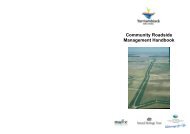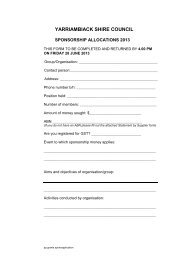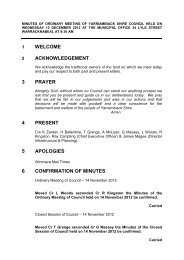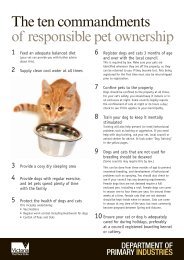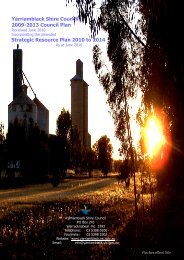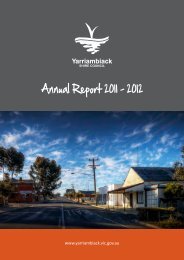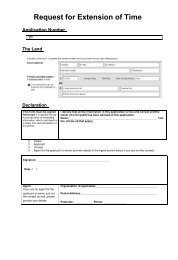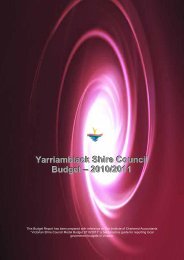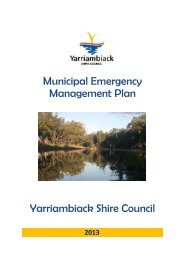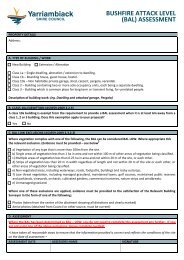2010 - Yarriambiack Council
2010 - Yarriambiack Council
2010 - Yarriambiack Council
- No tags were found...
You also want an ePaper? Increase the reach of your titles
YUMPU automatically turns print PDFs into web optimized ePapers that Google loves.
NOTES TO THE ACCOUNTS<br />
Note 1 Significant Accounting Policies (continued)<br />
Sick Leave gratuity<br />
A gratuity is provided to all employees who have accumulated 20 years of service with this <strong>Council</strong> or<br />
its immediate predecessors. The liability represents a set proportion of accumulated sick leave that is<br />
paid on resignation, retirement or retrenchment. At balance date, the liability is measured at the<br />
present value of estimated future cash flows to be made for this entitlement. Commonwealth bond<br />
rates are used for discounting future cash flows.<br />
(l)<br />
Leases<br />
Finance Leases<br />
Leases of assets where substantially all the risks and benefits incidental to ownership of the asset,<br />
but not the legal ownership, are transferred to the <strong>Council</strong> are classified as financial leases. Finance<br />
leases are capitalised, recording an asset and a liability equal to the present value of the minimum<br />
lease payments, including any guaranteed residual value. Leased assets are amortised on a straight<br />
line basis over their estimated useful lives to the <strong>Council</strong> where it is likely that the <strong>Council</strong> will obtain<br />
ownership of the asset or over the term of the lease, whichever is the shorter. Leased assets are<br />
currently being amortised over a 1 to 5 year period.<br />
Operating leases<br />
Lease payments for operating leases are recognised as an expense in the years in which they are<br />
incurred as this reflects the pattern of benefits derived by the <strong>Council</strong>.<br />
(m)<br />
Allocation between Current and Non-Current<br />
In the determination of whether an asset or liability is current or non-current, consideration is given to<br />
the time when each asset or liability is expected to be settled. The asset or liability is classified as<br />
current if it is expected to be settled within the next twelve months, being the <strong>Council</strong>’s operational<br />
cycle, or if the <strong>Council</strong> does not have an unconditional right to defer settlement of a liability for at least<br />
12 months after the reporting date.<br />
(n)<br />
Agreements equally proportionately unperformed<br />
The <strong>Council</strong> does not recognise assets and liabilities arising from agreements that are equally<br />
proportionately unperformed in the balance sheet. Such agreements are recognised on an “as<br />
incurred” basis.<br />
(o)<br />
Web Site Costs<br />
Costs in relation to websites are charged as an expense in the period in which they are incurred.<br />
(p)<br />
Goods and Services Tax<br />
Revenues, expenses and assets are recognised net of the amount of GST, except where the amount<br />
of GST incurred is not recoverable from the Australian Tax Office. In these circumstances the GST is<br />
recognised as part of the cost of acquisition of the asset or as part of an item of the expense.<br />
Receivables and payables in the balance sheet are shown inclusive of GST.<br />
Cash flows are presented in the cash flow statement on a gross basis, except for the GST<br />
component of investing and financing activities, which are disclosed as operating cash flows.<br />
(q)<br />
Impairment of Assets<br />
At each reporting date, the <strong>Council</strong> reviews the carrying value of its assets to determine whether<br />
there is any indication that these assets have been impaired. If such an indication exists, the<br />
recoverable amount of the asset, being the higher of the asset's fair value less costs to sell and value<br />
in use, is compared to the assets carrying value. Any excess of the assets carrying value over its<br />
recoverable amount is expensed to the comprehensive income statement.<br />
Annual Report 2009/10 52



